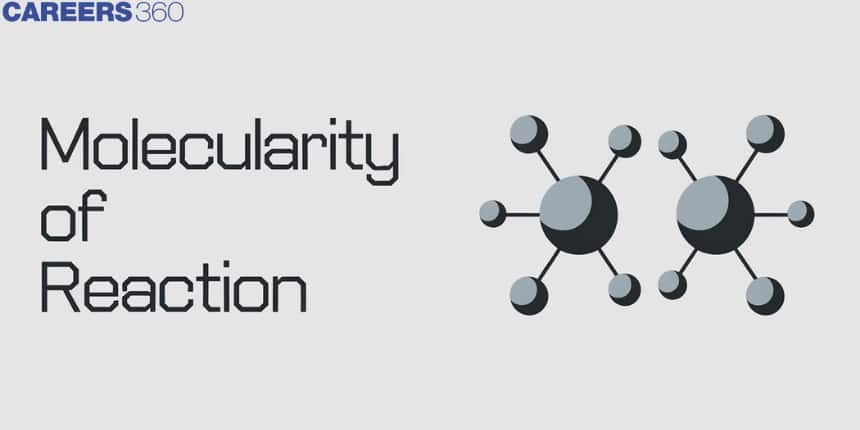Molecularity of Reaction
Imagine that you are cooking a complicated recipe in your kitchen. You follow a recipe in which the sequence of adding the ingredients is important. You add A, B and C in steps. When you mix them wrongly or at a wrong time, it won't result in the desired outcome. The case may be compared to that in chemical reactions where the order and manner of contact between the reactant molecules might thoroughly change the results. Something termed "molecularity" defines this interaction in chemistry. In chemistry, it gives the snap-shot of how collision and reaction occur among reacting molecules to form products. It presents the concept of molecularity, encompassing its definition, the types of molecularity, and its point in theory or practical application.
- Molecularity of Reaction
- Significance and Applications
- Some Solved Examples

Molecularity of Reaction
Molecularity is referred to as the number of reactant molecules coming together simultaneously to collide with each other and enter into the transition state that finally leads to a chemical reaction. This approach is used to describe theoretically the mechanism of elementary reactions. depending on whether it involves one, two, or three molecules, then it is said to be unimolecular, bimolecular, or termolecular, respectively. For instance, in a unimolecular process, one molecule undergoes a change; this might be just the isomerization of cyclopropane into propene. Knowing the molecularity helps to know what exactly happens at each particular step and which steps the mechanism comprises for a reaction.
The number of reacting species (atoms, ions or molecules) taking part in an elementary reaction which must collide simultaneously in order to bring about a chemical reaction is Molecularity.
Description:
NH4NO2→N2+2H2O(unimolecular) H2+I2→2HI (bimolecular) 2NO+O2→2NO2 (trimolecular)
Molecularity is the theoretical concept. It cannot be zero/non-integer
Type of Molecularity
1. Unimolecular Reactions: This involves one reactant molecule going to the products. A very good example is the decomposition of dinitrogen pentoxide, N₂O₅, to form nitrogen dioxide and oxygen.
2. Bimolecular Reactions: Reactions involving two colliding reactant molecules. The classic example is the reaction of hydrogen, H₂, with iodine, I₂, forming hydrogen iodide, HI.
3. Termolecular Reactions: These are the least frequent due to the extremely low probability of three molecules hitting together at the same time. An example is the formation of ozone from oxygen molecules and atoms in the atmosphere.
Each of these kinds of molecularity details the richness in reaction mechanisms and, therefore, speaks to the complexity of the chemical process.
Significance and Applications
Molecularity of reactions is used in both academic and industrial circles. It helps in the learning of subtleties of the reaction mechanism and kinetics in an academic setup for students and researchers. For example, studies on unimolecular reactions have contributed knowledge with respect to isomerization and stability of species. Knowledge of molecularity becomes very important in applications related to industrial processes, as it is instrumental in the optimization of chemical reactions. For example, the production of ammonia by the method of Haber requires knowledge about the molecularity of the reactions between nitrogen and hydrogen molecules. Tetramolecular processes are very important in atmospheric chemistry, helping to explain the phenomena of formations and destructions of the ozone layer. Knowing molecularity could lead to the design of better catalysts, improvement in yields in reactions, and environmentally more benign chemical processes.
Recommended topic video on (Molecularity of reaction)
Some Solved Examples
Example 1
Question:
The molecularity of a reaction depends on:
1) Pressure
2) Temperature
3) Both temperature and pressure
4) None of the above
Solution:
The number of reacting species (atoms, ions, or molecules) taking part in an elementary reaction that must collide simultaneously to produce a chemical reaction is Molecularity. The molecularity of a reaction is independent of pressure and temperature.
Hence, the answer is the option (4).
Example 2
Question:
Which one of the following is correct about the molecularity of a reaction?
1) It is the number of reacting species undergoing simultaneous collision in an elementary or simple reaction.
2) It is a theoretical concept and can be calculated by simply adding the molecules of the slowest step.
3) It is always a whole number value only, i.e., 1, 2, 3, etc.
4) All of the above
Solution:
Molecularity is the number of reacting species undergoing simultaneous collision in an elementary or simple reaction. It is always a whole number value only, i.e., 1, 2, 3, etc. It is a theoretical concept and can be calculated by adding the molecules of the slowest step.
So, all statements are correct.
Hence, the answer is the option (4).
Example 3
Question:
A reaction involving two different reactants can never be:
1) Unimolecular reaction
2) First-order reaction
3) Second-order reaction
4) Bimolecular reaction
Solution:
The number of reacting species (atoms, ions, or molecules) taking part in an elementary reaction that must collide simultaneously to bring about a chemical reaction is Molecularity. So, a reaction involving two different reactants can never be an unimolecular reaction.
Hence, the answer is the option (1).
Summary
The molecularity of a reaction is the central theme in chemistry and acts more or less as a window to knowledge regarding the mechanism/fittingness of a set of chemical reactions. It classifies varied reactions into classes based on the number of molecules taking part as reactants in any one elementary reaction. These categories are very useful both for theoretical insights and practical applications right from academic studies to industry production lines and environmental science. Thus, knowing the molecularity allows easier control and prediction of the course of chemical reactions; hence, the field has opened avenues for several advances within the domain of chemistry.
Also Read
19 Feb'25 04:56 PM
19 Feb'25 04:50 PM
19 Feb'25 04:42 PM
06 Feb'25 11:52 PM
30 Sep'24 11:45 AM
25 Sep'24 09:40 AM
25 Sep'24 09:39 AM
24 Sep'24 09:46 PM
24 Sep'24 09:40 PM
23 Sep'24 01:58 PM

